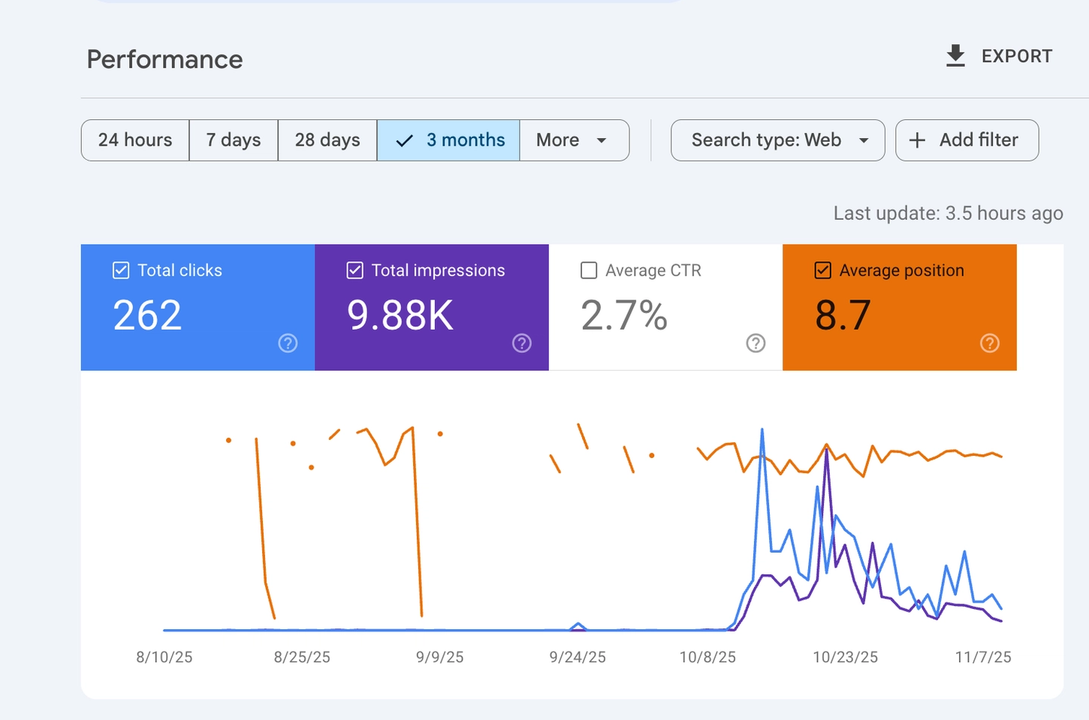
SEO Built from the Start capturing MQL in days not years | Invest How Now | Case Study
InvestHowNow.com began as a small, focused experiment: an early-stage platform exploring how founders and angels could make better-aligned investment decisions. The goal wasn’t to go viral. It was to prove that a new domain, with no backlinks and no brand history, could quickly earn qualified organic leads by baking SEO and systems thinking into the build itself.
SEO is known for taking a long time to make impact and is often an afterthought. Professionals generally say it takes around 6 months or more to see results - which can be true for more mature sites/brands and highly competitive spaces.
- Semrush notes that it typically takes 4–12 months for SEO to begin showing measurable impact, depending on competition and resources (Semrush, 2023).
- Ahrefs found that newly published pages take 3–6 months to start ranking in search results, with older, higher-authority domains seeing faster results (Ahrefs, 2024).
- Shopify adds that while three to six months is a common window, the true timeline depends heavily on domain authority, content quality, and industry competitiveness (Shopify, 2025).
In this context, InvestHowNow.com—a brand-new .com with no prior authority—achieved verified traction in under 12 weeks, performing ahead of these industry averages.
The challenge
The site launched on a fresh domain in August 2025 with no history, no backlinks, and no paid promotion.
The hypothesis was straightforward:
Could an early-stage idea generate genuine, qualified traction through organic search alone. No paid ads nor outbound campaigns?
Alongside, the project carried the business model development goal:
to validate early interest for the upcoming Fit OS concept, which will help both founders and investors assess alignment before contact is made.
- Fit Signal Map: for founders to understand readiness, clarify your story, and know which angels to speak with and why.
- Pattern Insight Card: for angels to maintain thesis clarity, focus where alignment exists, and protect attention from noise.
Approach: Building for Search Intent alignment
Instead of treating SEO as a marketing layer, it became the build framework.
Every decision served discoverability, data and content quality, and operational simplicity.
This mindset naturally aligns with the principles of Google's Helpful Content System (HCS); which prioritises content that genuinely serves users, not algorithms. It rewards relevance, trust, and usefulness over volume or keyword repetition.
In practice, that meant:
- Building from intent, not topics: identifying what people are trying to work out, then structuring the content around those real moments of search.: identifying what people are trying to work out, then structuring the content around those real moments of search.
- Designing for comprehension: ensuring each component, from copy to schema, helps both users and crawlers understand meaning accurately.
- Prioritising operational transparency: using analytics, CRM flows, and tracking to see how people actually navigate, decide, and return.
By grounding every design and technical choice in helpfulness and interpretability, the site could generate authentic engagement signals faster: steady dwell time, low bounce rates, and consistent return visits. These are the same soft signals the Helpful Content System recognises when evaluating content that adds genuine value.
Technical stack
The following techstack is mostly open-source and selected for speed performance, flexibility, robust frameworks, security and trust-building.
- Next.js + Vercel v0 for speed and reliability
- Sanity headless CMS for structured, schema-ready content
- Cloudflare Registry for DNS and SSL
- GitHub CI/CD for version control and deployment
- Web3Form + hCaptcha + Resend for CRM tracking
- Google Search Console (GSC) + Google Analytics (GA4) + GTM for behavioural and conversion analytics
SEO from the start
The first content went live in late August 2025, within three weeks of launch, ensuring Google could begin discovering relevance before formal indexing began in early October.
XML sitemaps, canonical tags, and dynamic metadata launched with the first deployment.
Semantic blog architecture focused on search intent topics such as “How angel investors choose startups to back” and “Identifying the funding path after your raise.”
Schema markup and descriptive Open Graph data made the content clear to both users and crawlers.
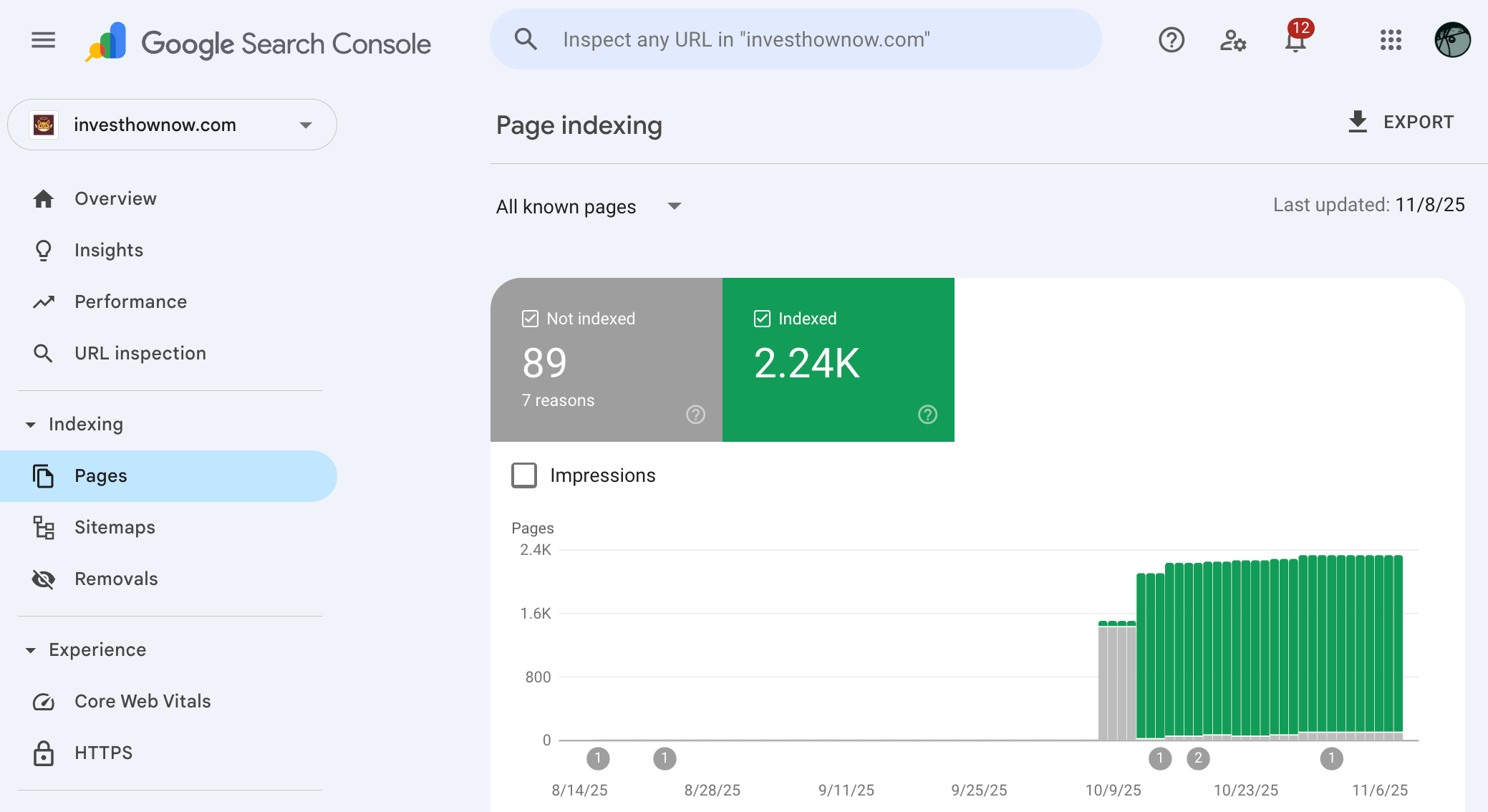
2.24 K pages indexed within weeks of launch.
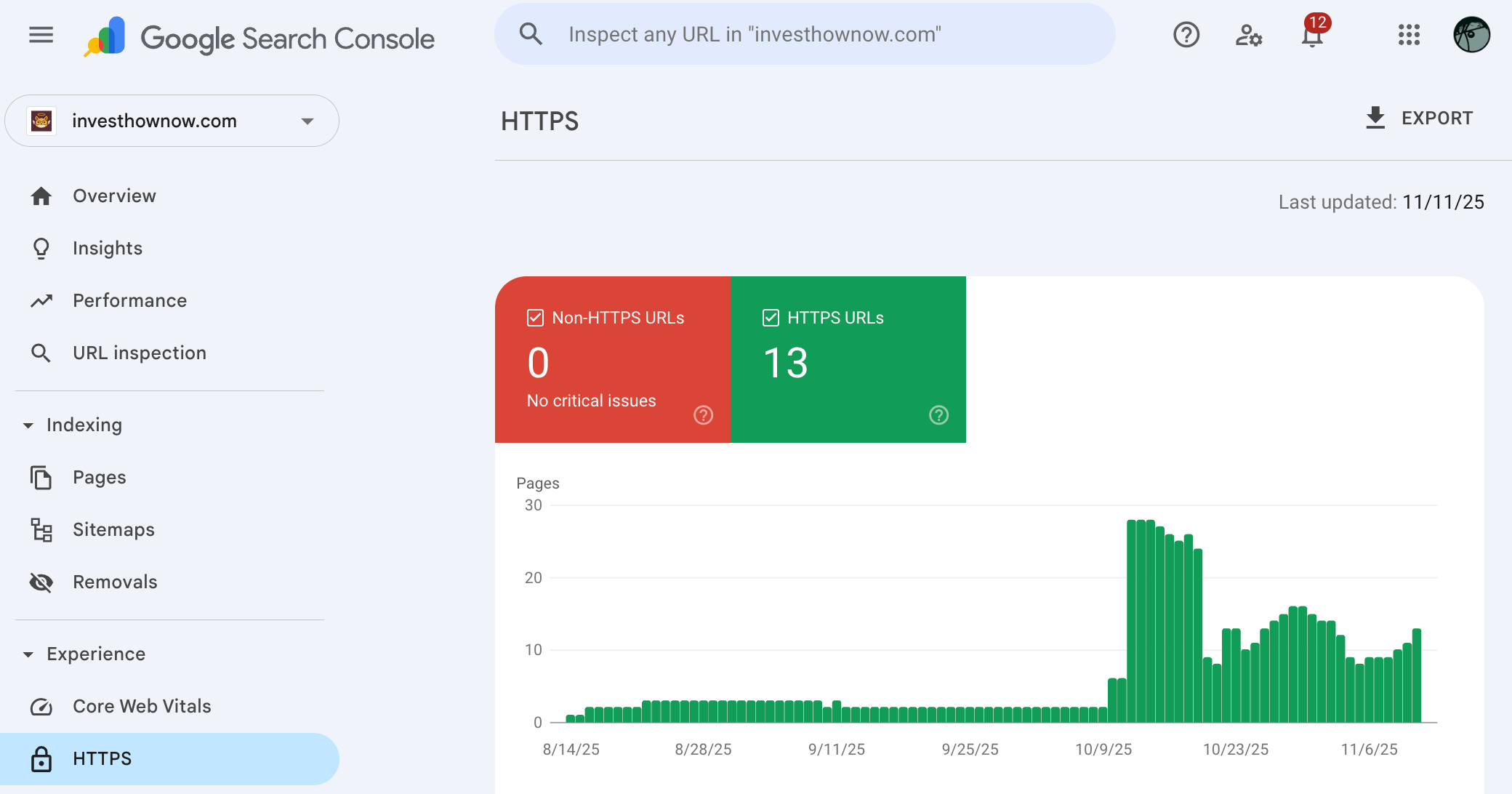
All pages served securely via HTTPS.
Timeline and results
| Phase start / Milestone | Date |
|---|---|
| Domain, branding and coding start | Aug 7 |
| Keyword research & analysis | Aug 11 |
| Early site v go-live | Aug 11 |
| First blog post published | Aug 13 |
| First pages indexed by Google | Aug 16 |
| Guest post published | Aug 20 |
| Data build | Aug 21 |
| Third content piece published | Aug 21 |
| 88 pages indexed | Oct 8 |
| 2k+ pages indexed | Oct 12 |
| Fourth post published | Oct 13 |
| First qualified lead (MQL) | Oct 16 |
| Fifth post published | Oct 21 |
| LinkedIn page created | Oct 21 |
| Second MQL | Nov 6 |
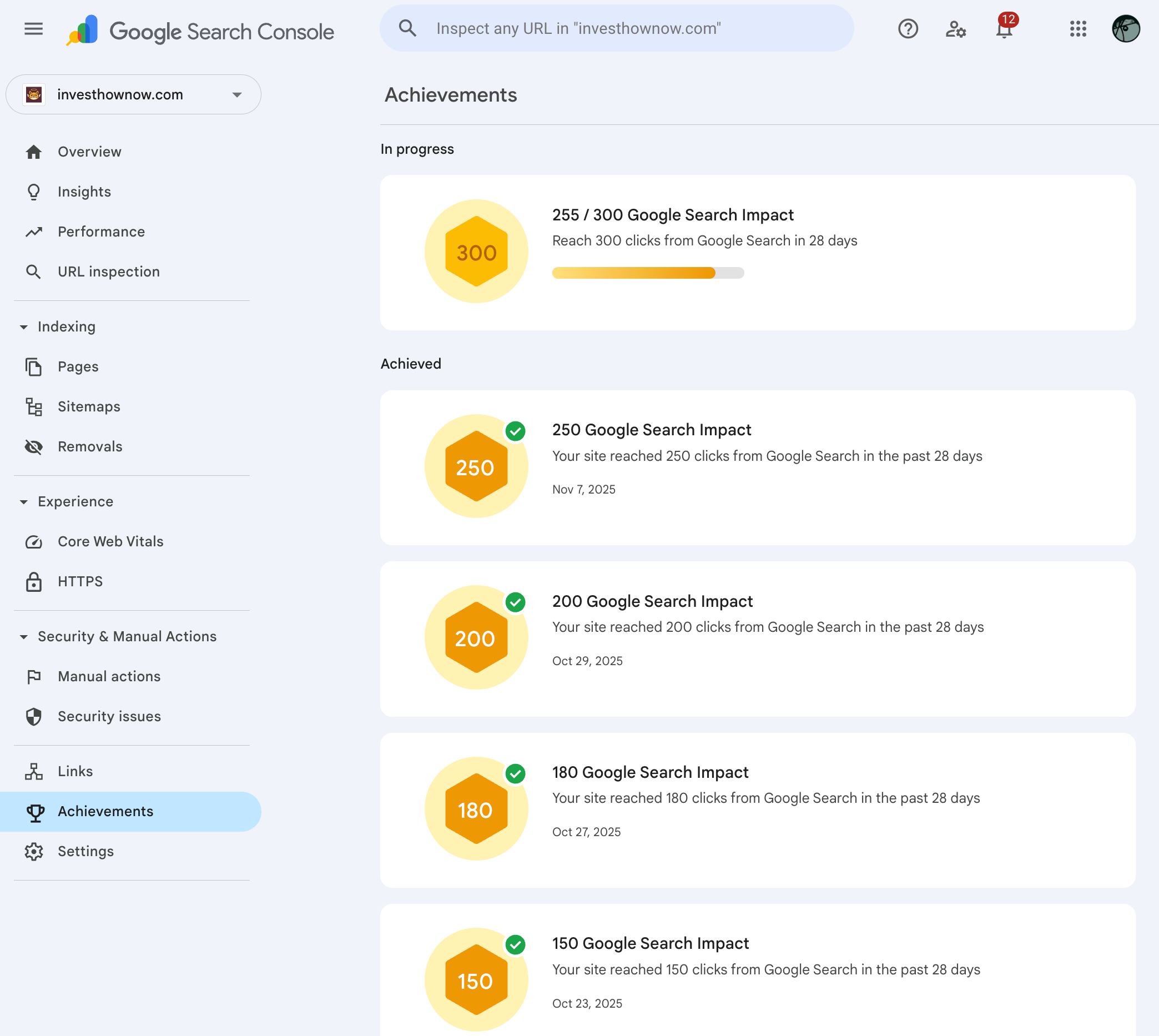
Milestone progression from 5 to 250 organic clicks in 28 days.

Week-to-week organic growth.
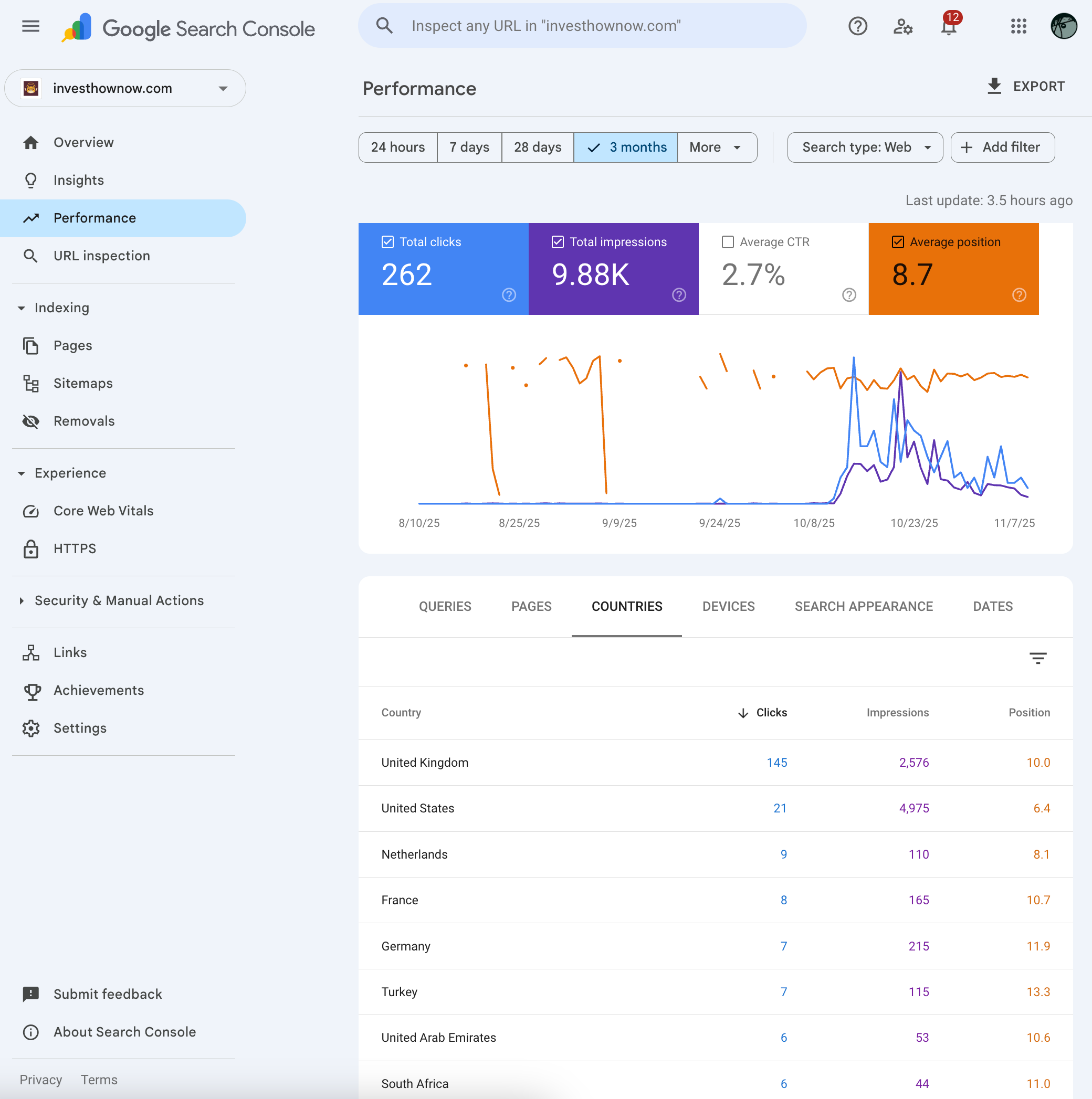
Key metrics (Oct → Nov 2025)
- 9.8k+ impressions
- Average position ≈ 8.7
- 262 organic clicks
- 2.7% average CTR
- 2 verified inbound leads
No paid traffic. Total spend limited to the domain hosting and legwork.
Signals that mattered
The work started with patterns in language / search query data, not assumptions alone.
Instead of chasing keyword volume, I used Google Keyword Planner to surface how people described the space: the phrases, comparisons, and uncertainties that kept showing up.
Those raw terms were then clustered using a custom Search Intent model, grouped by shared meaning and search intent rather than by keyword metrics alone. Each cluster represented a moment of sense-making.
Rather than forcing these clusters into a marketing funnel, I mapped them to intent zones, from early exploration through to moments of consideration and validation, to reflect how people genuinely think and search online.
Reflection
Most teams treat SEO as something to invest in later. This project proved what happens when it’s part of the foundation. Real traction isn’t luck; it’s alignment between intent, structure, and timing.
By integrating branding, design, data and search engine strategy from the start, the site reached meaningful organic traction faster than standard benchmarks.
The same principles now guide the next stage for Invest How Now: Fit OS, where mapping founder and investor “fit signals” will help both sides focus attention where it counts.
Key Takeaways
- Begin SEO and analytics at planning and strategy phase, not post-launch.
- Treat content as evidence of understanding, not filler.
- Prioritise technical SEO before cosmetic branding perfection.
- Use early organic data as a feedback loop for product and messaging decisions.


